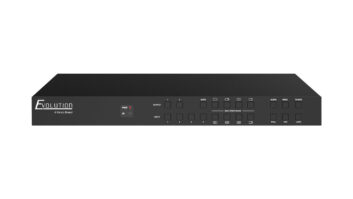Richmond, Va. — Circuit City Stores pushed up sales in its domestic stores segment 14.4 percent during the retailer’s fiscal third quarter, reaching $2.7 billion, up from $2.4 billion in the same three months last year. Domestic comp-store sales climbed 13.3 percent.
Gross profit for Circuit City’s domestic stores business increased to $644.2 million in the third quarter, up from the prior year’s $581.8 million. Net earnings from continuing domestic segment operations moved into the black during the third quarter, hitting $13.1 million, compared with a loss of $11.4 million in the same three months last year.
At the same time Alan McCollough, chairman/CEO announced he will retire as CEO on Feb. 28, 2006, and as board chairman at the 2006 annual shareholders meeting. Phil Schoonover, who has been president since earlier this year, will take over as CEO on March 1. He has been elected to the company’s board. (See related story.)
Commenting on the chain’s sales performance, McCollough said, “Our sales growth is largely attributed to increases in close rate and average ticket, since store traffic for the quarter was relatively flat. During the quarter, we also made significant investments in innovation, a new point-of-sales system and our merchandise systems transformation.”
Circuit City’s sales during the third quarter were led by strength in flat-panel TVs, portable digital audio products, notebook computers and digital imaging products. The retailer also enjoyed “impressive sales gains” in its Internet sales, with Web- originated revenue growing 74 percent year-over-year in the third quarter.
Excluding warranty and installation revenue, domestic segment video sales jumped to a 46 percent share, from 43 percent year-on-year, while audio sales rose to a 15 percent share, from 14 percent. Information technology sales in the three months dropped to a 28 percent share, from a year-earlier 30 percent, while entertainment category sales came in at 11 percent, down from 13 percent in the third quarter last year.
The video category produced a double-digit comp-store sales increase in the third quarter, with television increasing by double digits and flat-panel displays showing triple-digit sales growth for the quarter ended Nov. 30. Growth in television sales and double-digit comp-store sales growth in digital imaging were partially offset by double-digit comp-store sales declines in DVD players.
The information technology category produced a single-digit comp-store sales increase in the third quarter, driven by a double-digit comp-store sale rise in notebook computers.
In audio, Circuit City produced a double-digit comp-store sales increase in the third quarter, primarily reflecting triple-digit comp-store sales growth in portable digital audio products. Double-digit comp-store sales growth in mobile audio products reflected growth in digital satellite radio and navigation products.
Portable and mobile audio products comp-store sales increases were partially offset by a single-digit comp-store sales decline in home audio products.
In the entertainment category, the retailer produced single-digit comp-store sales decreases in the third quarter, reflecting a double-digit drop in music software and game products, partially offset by a single-digit rise in video software.
Domestic stores warranty revenue climbed to $104.7 million in the third quarter, up from $91 million year-over-year. The 3.8 percent of domestic segment sales enjoyed by the warranty business in the third quarter remained the same as the corresponding three months in 2004.
The domestic business gross profit margin dropped nearly 1 percent in the third quarter, due to a decline in store merchandise margin stemming from continued margin rate declines in video software, as the retailer continued efforts to remain competitive in the marketplace by driving traffic through aggressive movie pricing and projection TVs. Costs associated with the company’s promotional financing program also drove down domestic gross profit margin.
In the expenses arena, the domestic expense-to-sales ratio declined nearly 2.5 percentage points in the third quarter, reflecting leverage on higher sales and less store relocation activity compared with the prior year. These gains were partially offset by $15.6 million in higher advertising expenses.
“We view the additional advertising expense during the quarter as an important investment in building the Circuit City brand,” said McCollough. “Since our retail stores team held labor expense relatively flat on a dollar basis, we were able to gain significant leverage on our higher level of sales as we continued work to optimize the labor model in our stores,” he said.
Consolidated Circuit City sales jumped 14.7 percent in the third quarter, hitting $2.9 billion, up from $2.5 billion in the same quarter in 2004, with comps rising 13.1 percent.
Net earnings moved into the black, at $10.1 million, compared with a loss of $5.9 million in the same period a year ago. Gross profit margin declined to 24.2 percent, from 25.2 percent, while expenses decreased to 23.3 percent in the three months, down from the prior year’s 25.3 percent.
For the nine months, domestic segment sales rose 8.1 percent, reaching $7.3 billion, up from $6.7 billion. Comps rose 6.5 percent. Net earnings from continuing operations came in at $7.8 million, compared with a loss of $31.8 million year-on-year.
Consolidated sales for the nine months increased to $7.7 billion, up from a year-earlier $7 billion, while the company reduced its net loss to $1.6 million, compared with a loss of $23.8 million in the same period last year.
Gross profit margin for the nine months was reported at 24.3 percent, down from 24.6 percent the previous year, while expenses dipped to 24.1 percent, down from 24.9 percent during the first nine months of 2004.













